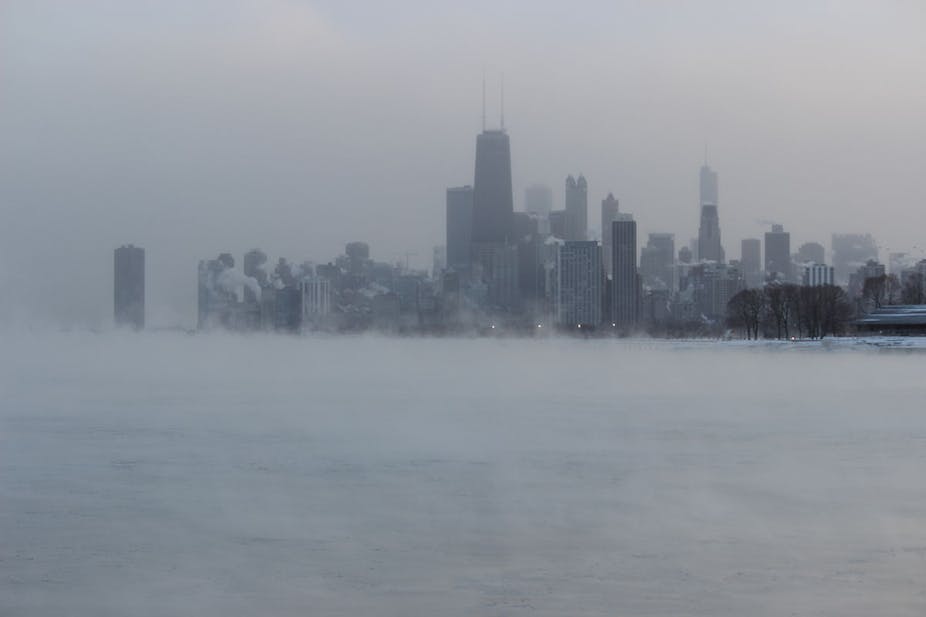The climate is warming, and so basic logic would suggest we should expect fewer bouts of cold weather. Yet severe winter weather, such as the cold wave over the US this year, and the chilly winter of 2009/10 in the UK have left people questioning this assumption.
In early January 2014, across North America record minimum temperatures for the date were set at many weather stations, including at Chicago O’Hare Airport (-26.7°C, January 6), New York Central Park, (-15.6°C/4°F, January 7) and Washington DC Dulles Airport (-17.2°C, January 7). Daily maximum snowfall records were also broken at several stations. The cold temperatures and heavy snowfall caused widespread disruption to transport and power supply, closure of work places and public services, and damage to crops.
Unsurprisingly given the disruption, the national and global media extensively reported the cold wave, including debate on whether or not human-induced climate change was partly responsible. One particular hypothesis garnered a lot of attention: the suggestion that rapid Arctic warming and associated sea ice loss may be increasing the risk of cold extremes.
The theory goes something like this: as the Arctic has warmed more rapidly than places further south, a phenomenon known as Arctic amplification, the north-south temperature gradient has weakened. This temperature gradient powers the jetstream, a strong wind, high in the atmosphere that marks the boundary between cold Arctic air and warmer air to the south. A weaker north-south temperature gradient may cause a weaker jetstream. It’s also argued that a weaker jetstream will meander more, a bit like a river meanders more when the current is slower. When large southward meanders develop, Arctic air pushes south leading to cold conditions. This hypothesis has led to recent claims that Arctic warming will lead to more cold weather.

My latest research published in the Nature Climate Change journal, analyses thousands of weather records and suggest a more important – and remarkably simple – connection between Arctic warming and our weather. This link implies the opposite, that rapid Arctic warming will lead to fewer, not more, cold extremes.
Generally speaking (in the northern hemisphere), when the wind blows from the north temperatures tend to be colder than average. Conversely, when the wind blows from the south temperatures tend to be warmer than average. Cold extremes, those really cold days, occur most frequently when the wind is from the north. This is no real surprise, as the poles are cold and the tropics and equator to our south are warm.
What the data shows, however, is that days in autumn and winter with northerly winds (blowing from the north) have warmed significantly more than days with southerly winds. The result is a levelling off of temperatures at a new, warmer average as cold days’ temperatures rise towards the temperatures of warm days faster than the warm days themselves increase in temperature. Scientists call this a decrease in temperature variance, and it implies fewer temperature extremes, in this case notably fewer cold extremes.
Again, this makes perfect sense if you consider that the Arctic has warmed more rapidly than places further south. Cold northerly winds are not as cold as they were in the past, because the Arctic air they bring is, like the rest of the Arctic, considerably warmer than it once was.
The latest climate models suggest that these changes will continue and become more widespread in the future. I examined simulations from 34 different climate models, each run with projected increases in greenhouse gas concentrations. The models all agree that temperatures will warm in all seasons. Towards the pole beyond 40 degrees north, which includes large parts of US, Europe and Asia, temperatures are anticipated to become less variable in all seasons except summer. A warmer and less variable climate has fewer cold extremes.
There is still a lot to understand about how the dramatic changes occurring in the Arctic will affect weather patterns further south – in particular, if and how the jetstream might be affected will be vital. But there is strong evidence that Arctic warming is taking the edge off those cold northerly winds, meaning the risk of extreme cold waves like that experienced in the US becomes rarer still.

